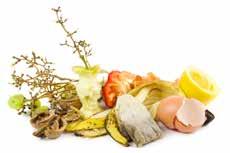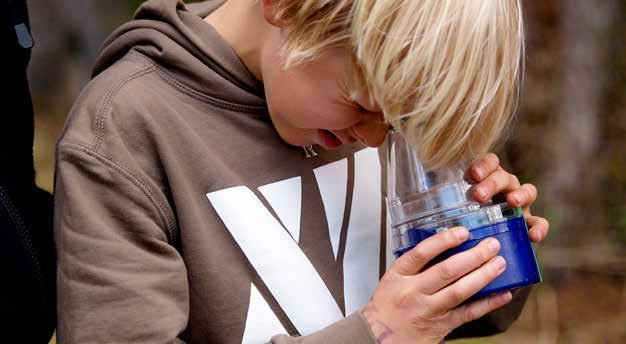
6 minute read
Civics
21. Recycling
Purpose: To create understanding of why it is important to recycle materials from our waste.
Advertisement
Age: Any.
Paper, newspapers and cardboard All paper can be recycled. This saves resources and energy since much less energy is needed to recycle used paper than to make new paper from forest resources.
Taking the earth’s resources and making products that later become waste is not sustainable in the long run. Partly because the resources will run out and partly because our mountains of waste will grow and grow. The alternative is to use the earth’s resources sparingly and only manufacture products that can be recycled. What we use will then be able to be used as new material time and time again. We can then make sure that the earth’s resources are sufficient and minimize our waste.
In Sweden today we have municipal recycling centres where we can take paper, newspapers, cardboard, plastic, glass and organic material. Materials that can be recycled are sorted out from the rest. Materials that can be burned are taken to a refuse incineration plant where the heat produced is used to heat homes and other buildings. Organic material is turned into biogas, which can be used as fuel for buses and cars. Biogas is a source of energy that is much better than petrol, which is a finite resource.
Metal All of 8 % of the earth’s crust consists of aluminium, making it the most common metal. This means that of 100 kg of earth, 8 kg is aluminium! It can be found everywhere: in the earth, in the air and in the food we eat. Even if it is a plentiful resource, one big problem is that it takes a lot of energy to extract aluminium. But if we recycle aluminium instead, we save 95 % of the energy that is needed to extract aluminium from the earth directly.
We can save almost the same amount of energy if we recycle steel and since metal can be recycled over and over again every little piece of metal is very valuable.
Plastic About 4 % of the world’s oil consumption is used to make plastic. Since oil is not renewable it is not sustainable to use it at the rate we do today. We can recycle plastic instead and reduce our mountains of waste. Organic material All organic waste is valuable since it can be composted and transformed into nutrient-rich soil that can be used as an alternative to artificial fertiliser.
Glass Another material that can be recycled several times is glass. Recycling glass saves 20 % of the energy that it takes to make new glass.
22. Study different materials.
Purpose: To learn about different materials’ properties and their place in the eco-cycle.
Age: Can be adapted to different ages. Ask the pupils to collect some different materials from the rubbish bins. Go through the things they have collected and talk about where the materials come from and how they are made. Write the name of each material in a table (see below) and ask the pupils to guess what their properties are (magnetic, sinks/floats and degradable). Then ask the pupils to test these properties practically and enter the results in the table. To test degradability, you can nail the materials to a plank of wood which you then bury in the ground. After a couple of months, dig it up again to see what has happened.
Material
Plastic
Aluminium
Metal
Paper
Cardboard
Glass
Organic material
My guess Result
What can the things be recycled into? Draw a line between a material and an object.
Pink
Toilet paper
New cars
Playground equipment
Fibreglass Paper bags
23. Where does soil come from and what organisms can decompose materials?

Purpose: Understand nature’s eco-cycles, the importance of insects and other small organisms/animals and the importance of an unpolluted world.
Age: Any.
Study soil. Dig in the ground and see if you can find some worms or beetles. Gather them up and study them with a magnifying glass. How many legs do the animals have? What do they eat? What does their life cycle look like? In what way is the animal important to us? Try to find out what the animals are called. Plant some large seeds or beans in small boxes. Study how they grow and how the leaves develop. Plant them in six different boxes and compare how they develop in different environments. Place one box in a light place and one box in a dark place; water one box and leave one without water; plant the seeds/ beans in sand; plant the seeds/beans in nutritious soil. Have the children give their ideas about what will happen. Compare.
24. Counting in percent with a globe
Purpose: Practice percentages and geography.
Age: 9 and over.
How much of the earth is covered by water? Test the proportion of land to water by having the pupils throw a beach ball in the form of an inflatable globe between themselves. Have them throw the ball 10 times and count out loud how many times someone’s right thumb lands on water and on land. Then try 20 times, maybe 100 times. What percentages does this give? Does this agree with your theory?
(Answers: About 71 % of the earth’s surface is covered by sea with saline (salt) water; the remainder consists of islands and continents.) Planet Earth – the water planet Almost ¾ of the earth’s surface is covered by water. We often believe and behave as if there is an unlimited supply of water. To illustrate the scarce resource that fresh water is, fill a 10-litre bucket or aquarium with water.
10 litres = 640 tablespoons (tbsp) and represents all the water on the planet
1. The oceans 2. Glaciers and polar ice 3. Groundwater 4. Freshwater lakes 5. Inland seas and salt lakes 6. The atmosphere 7. Rivers 622 tbsp 13 tbsp 4 tbsp 0.8 ml 0.8 ml 0.8 ml 0.001 ml
Of this water, only approximately 17 tbsp make up what is not oceans. Have the pupils place 17 tbsp in a container and take out the amount that represents freshwater lakes and rivers (approx. 0.05 tbsp or 0.8 ml – less than a drop). This is the amount of water on earth that we can drink – if we do not pollute it.
25. Small eco-cycle in a bottle
Purpose: To understand different kinds of cycles, for example water and carbon. To understand photosynthesis and that all organisms are interdependent. What are basic human needs?
Age: The exercise can be modified to suit all ages. Use a large demijohn made of glass or a large jar. Fill the bottom with coarsely crushed charcoal and cover with soil to fill approx. 1/4 of the jar. Using two long sticks, plant some small plants that can withstand high humidity. Put in 10 earthworms and add a cup of water. Seal tightly – there must be no evaporation – and do not open. Place the demijohn/jar somewhere light but not in direct sunlight. If you see any fungi, you have given your eco-cycle a little too much water. Open the container and leave it open for 24 hours. Then try again. Your little eco-cycle can now function for many years. The only question is: HOW?
Fantastic photosynthesis water + carbon dioxide + solar energy
water + oxygen + carbohydrates





